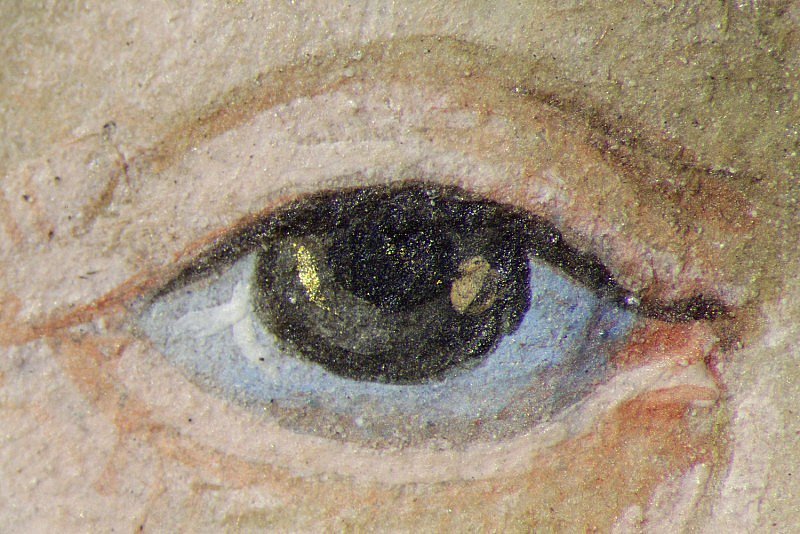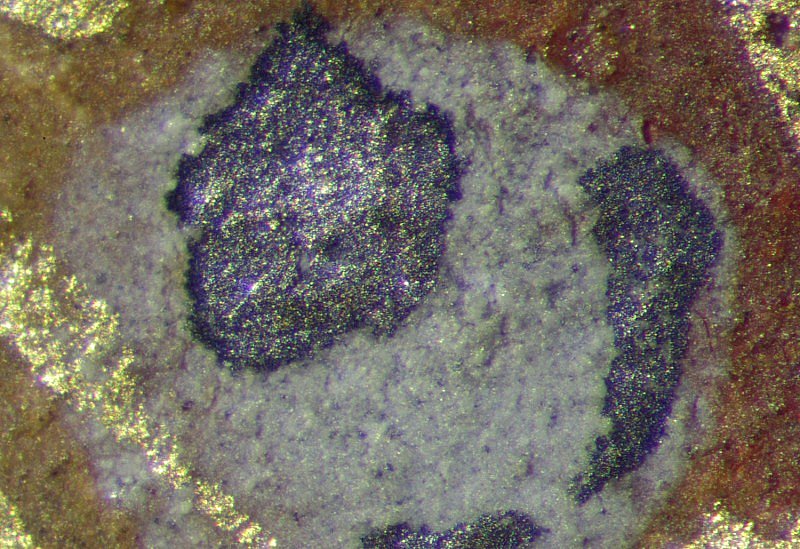Differences in palette
Artists' Materials
Some of the differences in palette identified within the manuscript allow us to specify the palette used by each of the four main artists. In most cases, the technical analysis supports the stylistic attribution of hands and paves the way for future analytical comparisons with other manuscripts attributed to these illuminators.
The palette of the Painter of Additional 15677 is characterised by the extensive use of red lead and by the presence of an organic yellow which supplements lead-tin yellow and the clay-rich ochre. He painted all blue areas with an azurite containing high levels of barium impurities. He also made extensive use of a green natural copper sulphate. He is the only artist to have chosen a purple dye, rather than a mixture of azurite and pink. He painted flesh tones with vermilion, lead white and small amounts of chalk.
His associates did not share his palette. Their images are characterised by the presence of indigo, the absence of the clay-rich ochre and the lack of vermilion in some flesh tones as well as the use of different blue and green pigments.
The Master of the Dresden Prayer Book was the only artist to use ultramarine blue and to mix red lead with lead-tin yellow in orange areas.
The three large images of saints painted by the Master of James IV of Scotland are characterised by the exclusive use of lead-tin yellow in yellow areas, the lack of significant impurities in the blue azurite, the presence of indigo in grey areas and of a copper pigment mixed with the clay-rich ochre, and the use of a copper carbonate or sulphate mixed with lead-tin yellow in green areas. The three architectural borders on these folios are the only ones amongst those analysed which contain mosaic gold. The palette used for the miniature of St Luke painting the Virgin on fol. 36r shows some differences, specifically the likely use of a lead oxide yellow and the absence of copper mixed with the clay-rich ochre, but doesn’t match the characteristic features of any of the other three artists.
The Master of St Michael painted flesh tones mostly with lead white and no chalk. He used a very pure azurite, which he also mixed with lead-tin yellow in some green areas, though he also employed a green copper carbonate, possibly malachite.


Christ as Saviour of the World (prayer Salve sancta facies)
This page was illuminated by the Painter of Additional 15677. Christ’s image is framed within an elaborately carved wooden structure casting shadows on the pink wall behind. It incorporates three-dimensional images of saints and the story of St Veronica painted in shell gold on a monochrome background, simulating a scene carved in relief. The frontispiece to the prayer ‘Hail, holy face’ fuses two popular devotional images – Christ as Saviour of the World (Salvator mundi), blessing and holding a crystal globe, and the Holy Face, Christ’s true image. The latter, not made by human hands, was miraculously imprinted on St Veronica’s cloth (known as the vernicle, sudarium or the Byzantine mandylion), when Christ wiped his face on the way to Golgotha.
Christ’s eyes reflect heavenly light, their glow painted in shell gold on one side, and a mixture of two luminous colours, vermilion and lead-tin yellow type I, on the other (hotspot 1). The globe is a pictorial study of reflection and refraction. Its silver highlights appear bright on the left side, but very dark – as if tarnished – on the right side. This may have been an intentional effect, aimed at conveying the three-dimensionality of this sphere. The dark grey outlines which decorate the grey gems in the medallion (hotspot 2) also contain silver.